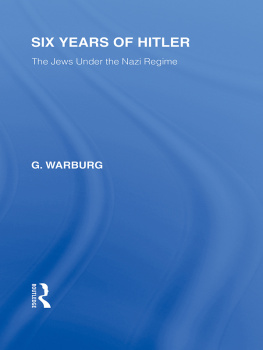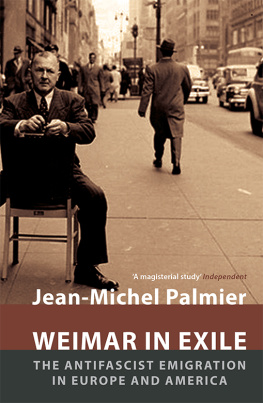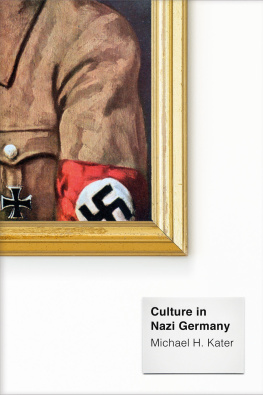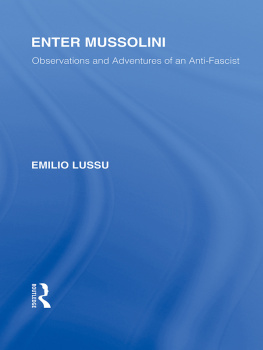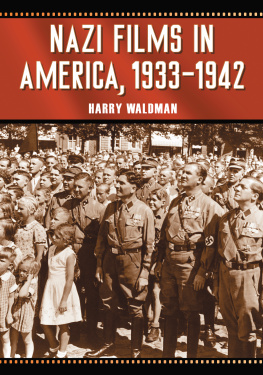ARTISTS
UNDER
HITLER
ARTISTS
UNDER
HITLER
COLLABORATION AND SURVIVAL IN NAZI GERMANY
JONATHAN
PETROPOULOS

Published with assistance from the foundation established in memory of Amasa
Stone Mather of the Class of 1907, Yale College.
Copyright 2014 by Jonathan Petropoulos.
All rights reserved.
This book may not be reproduced, in whole or in part, including illustrations, in any form (beyond that copying permitted by Sections 107 and 108 of the U.S. Copyright Law and except by reviewers for the public press), without written permission from the publishers.
Yale University Press books may be purchased in quantity for educational, business, or promotional use. For information, please e-mail (U.K. office).
Designed by Mary Valencia.
Set in Minion and ITC Franklin Gothic type by Integrated Publishing Solutions, Inc.
Printed in the United States of America.
Library of Congress Cataloging-in-Publication Data
Petropoulos, Jonathan.
Artists under Hitler : collaboration and survival in Nazi Germany / Jonathan
Petropoulos.
pages cm
Includes bibliographical references and index.
ISBN 978-0-300-19747-1 (hardback)
1. National socialism and art. 2. Arts, German20th century. 3. Artists
GermanySocial conditions20th century. 4. GermanySocial conditions
20th century. I. Title.
NX180.N37P48 2014
701'.03094309033dc23
2014021451
A catalogue record for this book is available from the British Library.
This paper meets the requirements of ANSI/NISO Z39.481992 (Permanence of Paper).
10 9 8 7 6 5 4 3 2 1
To Dennis, Christopher, and David
WHEN I VISITED France and Italy right after the war, I was full of that righteous antifascist feeling that we all had in the safety of America. I didnt want to meet the people who had, if not exactly collaborated, certainly had not fought the Nazis. I was too prissy. And then, as I began to learn more about Europe under the occupation, and what it was like, and to compare it to us, I became less prissy about it. Because the people who were defending their children and their lives were in a different situation from the people who were defending their swimming pools and their contracts at Metro. They werent brave enough to be partisans, but they hadnt sent any Jews to Auschwitz, either. I wasnt gonna be the one from America to tell them they were wrong. Of course, I never forgave the people who sent Jews to the camps. But I did get so I could forgive the people who entertained the German troops. What else were they gonna donot entertain them? Not entertain, and go where? If you had no group, if you were a group of one, what could you do? I can make a case for all the points of view.
ORSON WELLES
CONTENTS
Gallery follows
The bibliography for the book can be accessed at http://www.claremontmckenna.edu/hist/Artists-Under-Hitler/bibliography.php
PREFACE
IS THE NOTION of Nazi culture an oxymoron? Was any good culture produced during the Third Reich? There are, of course, the well-known accomplishments of Albert Speer and Leni Riefenstahl, Carl Orff, and Ernst Jnger. But conventional wisdom insists that any genuinely interesting art was rooted in the modernism of the Weimar Republic, while Nazi culture, with its rigidity and monumentality, was bad. This view is both coarse and wrong.
The cultural life of Nazi Germany was complex. Fascism did not defeat modernism. It persisted as an unresolved issue throughout Hitlers reign. Simply put, what are we to make of those cultural figures, many already with significant international reputations, who tried to find accommodation with the Nazi regime? And what effect, if any, did doing so have on their work? This book offers a more comprehensive and complicated understanding of culture during the Third Reich. While no single volume will ever be exhaustive, the history of these modernist (and modernist-influenced) artists goes a long way to capturing the rich and contentious cultural life of this period.
Modernism and modernist are terms that I use to refer to cultural figuresand their ideas and worksthat were in sympathy with avant-garde movements that rose and flourished in the last decades of the nineteenth and the first half of the twentieth century. Some historians have employed the phrase classic modernism, while others prefer modernisms to denote the plurality of styles and projects.with Arnold Schoenberg playing a particularly important role. Literature, for its part, featured an expressionist style of its own, although modernism in this discipline might also extend to nonlinear narrative structures and the efforts to give a voice to the poor and marginalized (for example, the works of mile Zola). There were parallel stylistic trends across the disciplines, as well as common intellectual projects: among them, Sigmund Freuds quest to understand the unconscious; a fascination with irrational impulses; an exploration of social alienation, and a desire to challenge the stale and oppressive conventions of the regnant order. That said, modernism can be an elusive concept, and for some it has more to do with a visceral impression. It is akin to U.S. Supreme Court Justice Potter Stewarts famous definition of pornographythat he knew it when he saw it.
My approach in this book rests upon a fairly expansive conception of modernism. I recognize that certain figures do not qualify as ideal typesthat their work and aesthetic philosophies contain contradictory elements. But all the figures treated at length here engaged modernist ideas in a meaningful manner at some stage of their careers. Rather than advancing a narrow conception of modernismand trying to force figures as varied as Barlach and Riefenstahl into a procrustean bedI argue for a broader and more flexible conception of the term: one that allows for more fruitful analytical comparisons and a more holistic examination of the multifaceted cultural history of the Third Reich.
I am also aware of the sensitivities that arise when one explores the engagement with National Socialism on the part of individuals who have long been viewed as anti-Nazi or, for that matter, those who were pro-Nazi. This finds expression in the word collaboration, which has myriad associations. While some scholars have used the word to denote complicity in the crimes of the Nazi regime, I take a more expansive definition that includes accommodation and the pursuit of accommodation.
The sensitivities attendant with the study of Nazi Germany demand certain responsibilities from the historian. Chief among them is scholarly and moral precision, and I take care to ensure that my sources are clearly identifiable. Researching this book compelled me to visit numerous archives and examine original documents, as well as to synthesize a vast secondary literature. In terms of the former, some figures presented particular challenges: for example, the painter Emil Nolde. I was denied access to his papers in Seebll in northern Germany and was advised simply to consult the existing scholarly literature. But this does not prevent a deeper understanding of the subjects. Even with figures as elusive and as private as Nolde in North Schleswig or Ernst Ludwig Kirchner in the Swiss Alps, there are rich sources to consult. Understanding the past is inherently fraught. I undertake it with humility in the hope that my efforts will shed light on what remains a dark and haunting time.
ARTISTS
UNDER
HITLER
Introduction
Next page

